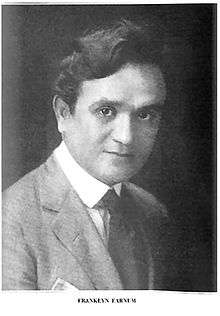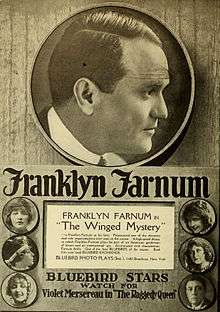Franklyn Farnum
| Franklyn Farnum | |
|---|---|
 Farnum in Photoplay Magazine, 1917 | |
| Born |
William Smith June 5, 1878 Boston, Massachusetts, U.S. |
| Died |
July 4, 1961 (aged 83) Woodland Hills, California, U.S. |
| Occupation | Actor, vaudevillian |
| Spouse(s) | |
| Children | 1 |
William Smith (June 5, 1878 – July 4, 1961), known by the screen name Franklyn Farnum, was an American character actor and Hollywood extra who appeared in 433 productions between the years 1916 and 1961. Farnum appeared as an actor in more films to win the Academy Award for Best Picture than any other (see below).
Life and career
Farnum was born in 1878 in Boston, Massachusetts, and became a vaudeville actor at the age of twelve. He was featured in a number of theatre and musical productions by the time he entered silent films near the age of 40. He appeared to be at his most comfortable in a saddle, his career dominated mostly by westerns. Some of his more famous films include the serial Vanishing Trails (1920) and the features The Clock (1917), The Firebrand (1922), The Drug Store Cowboy (1925), and The Gambling Fool (1925). He left films in 1925 but returned five years later at the advent of sound, only to find himself billed much further down the credits, if billed at all. However, he continued on in these obscure roles well into the 1950s.
One of his three wives was the ill-fated actress Alma Rubens, to whom he was briefly married in 1918. The couple divorced in 1919. He had one daughter, Martha Lillian Smith, who was born in 1898.
Smith appeared in seven Academy Award for Best Picture winners, more than any other actor in history: The Life of Emile Zola (1937), Going My Way (1944) (uncredited), The Lost Weekend (1945), Gentleman's Agreement (1947) (uncredited), All About Eve (1950) (uncredited), The Greatest Show on Earth (1952), and Around the World in Eighty Days (1956) (uncredited).
He died of cancer in Woodland Hills, California, in 1961 at the age of 83.
See also
Selected filmography

- The Empty Gun (1917)
- Anything Once (1917)
- The Scarlet Car (1917)
- Fast Company (1918)
- The Vanity Pool (1918)
- In Judgement Of (1918)
- The Virtuous Model (1919)
- Vanishing Trails (1920)
- The Land of Jazz (1920)
- A Desperate Adventure (1924)
- The Gambling Fool (1925)
- Rough Going (1925)
- The Third Alarm (1930)
- See America Thirst (1930)
- Gold Diggers of 1935 (1935)
- Fighting Caballero (1935)
- What Becomes of the Children? (1936)
- The Preview Murder Mystery (1936)
- The Life of Emile Zola (1937)
- In Early Arizona (1938)
- Stagecoach (1939)
- Meet John Doe (1941)
- Appointment in Berlin (1943)
- Hail the Conquering Hero (1944)
- Going My Way (1944) (uncredited)
- The Lost Weekend (1945)
- The Jolson Story (1946)
- Gentleman's Agreement (1947) (uncredited)
- Monsieur Verdoux (1947)
- Road to Rio (1947)
- Angel on the Amazon (1948)
- Johnny Belinda (1948)
- I Remember Mama (1948)
- The Fighting Kentuckian (1949)
- Destination Moon (1950)
- Sunset Boulevard (1950) - Undertaker
- All About Eve (1950)
- Strangers on a Train (1951) - Party Guest (uncredited)
- The Day the Earth Stood Still (1951)
- Here Comes the Groom (1951)
- The Bad and the Beautiful (1952)
- Carrie (1952)
- The Beast from 20,000 Fathoms (1953)
- A Star Is Born (1954) (uncredited)
- White Christmas (1954)
- Black Widow (1954)
- The Long, Long Trailer (1954)
- No Man's Woman (1955)
- East of Eden (1955)
- Guys and Dolls (1955) (uncredited)
- The Ten Commandments (1956) (uncredited)
- Around the World in Eighty Days (1956) (uncredited)
- Gunfight at the O.K. Corral (1957)
- My Man Godfrey (1957)
- Witness for the Prosecution (1957) as an old barrister (uncredited)
- King Creole (1958)
- Pillow Talk (1959)
External links
| Wikimedia Commons has media related to Franklyn Farnum. |